Tiki Culture. The Tiki Lifestyle. Island Living. Retro Life. What is it all about?
A lot of people ask me what this Tiki stuff is all about. Well, it’s pretty simple. It’s all about living the good life the way the cocktail set did back in the day; listening to the sounds of Exotica music and waves crashing on an island shore while sipping an exotic cocktail under a palm tree, and taking it nice and easy, even if you’re a thousand miles away from the nearest tropical island. That’s Tiki Culture.
People who are into Tiki Culture, or the “Tiki Lifestyle” crave an escape from the fast-paced lives we live. We want to know we have a special place, whether physical or in our minds, where we can go to get away from it all. For many of us, it’s our own little Tiki Bar set somewhere in the corner of our home. For some of us, it’s the Tiki Bar down town or on the beach. For a lucky few, our entire lives (including our homes and businesses) are 100% Tiki with that distinct mid-century retro look and feel.
Historically and geographically, Tiki is defined by Polynesian culture – specifically, Tiki was the first man on Earth, according to most cultures. But that’s not what 20th & 21st Century Tiki Culture in America (and most of the world) is about now. (There are a lot of great websites that can give you the history of Tiki and Moai better than I can here).
As for Tiki Culture today, you’ll get different answers depending on who you talk to, and from what part of the states they hail. Tiki purists will tell you that Tiki is the genre inspired by 1930s to 1950s Hawaiian and Polynesian pop styles, blending these cultures with specific types of drinks, food and décor. Dark woods, thatch, rattan and bamboo make up the basic building blocks of the décor and furniture. Tropical plants, waterfalls, hand-carved Tiki gods and Moai, along with nautical accents arranged in a somewhat mysterious display reminiscent of foreign lands make up an atmosphere of true Tiki. Dancing Hula girls and fire-eating island men provide the exotic entertainment, set to jazz-influenced, drum-heavy island music. Food is an Americanized combination of South Pacific and Asian cuisine; drinks are mostly rum-based, complex, fairly strong and are not really supposed to be sweet. Tropical Cocktails are at the center of the movement, and are served as a ritual – not just a drink – involving chunks of exotic fruits and even real flowers as garnish, exciting swizzle sticks, and occasionally even flames. Very special drinks are served in large bowls with extra long straws for a party of four; at places like the world famous Mai-Kai in Fort Lauderdale, FL they are served by a Mystery Girl dancing seductively to a gong.
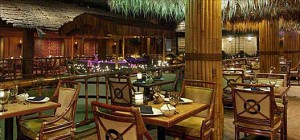
Anything made of plastic, with the exception of swizzle sticks, is taboo. If it wasn’t in a Tiki bar in the ’50s, it’s not authentic. However unless you are a true purist, a few fun plastic Tiki cups and paper cut outs from the party store can transform any room into your own Tiki haven without blowing the kids’ college fund on bamboo furniture and ceramic mugs.
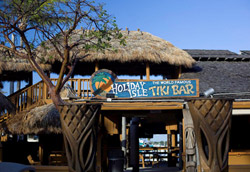
Swing down to Key West and the “Tiki Bar” takes on a whole new meaning. One of the few places in the country that welcomed Tiki bars through the ’70s, ’80s and ’90s, Tiki bars in the Keys evolved with the times and took on an area-specific life of their own. Bright, vivid colors replaced the dark jungle themes. Like everything else in the Keys, Tiki Bars became open-air, welcoming in the cool ocean breezes. Shorts, bikinis and flip-flops replaced party dresses and tailored suits for the dress code, and the music swayed away from Poly pop to Caribbean Island sounds, incorporating Cuban, Reggae, Calypso, and South American styles. Eventually a laid back kat named Jimmy Buffet made his way to Key West, and his music fit in perfectly with the Island’s philosophies. A Margarita or Cuba Libre are right at home next to the Mai Tai or Singapore Sling at the Tiki Bars in the Keys, and even though you won’t usually find a carved Tiki or a Polynesian show, they can still be a hell of a lot of fun.
Today, we have a wonderful bunch of krazy kats and kittens who refer to themselves as Tikiphiles. (Hell, you might be one of them yourself if you’re reading this!) These swingers love Tiki culture, in many forms. They might be purists, they might be Parrot Heads, or they might be into the Retro Scene where Tiki can be a big part. Some of the hard-core Tikiphiles follow Tiki events across the country – mainly the Big Three – Tiki Oasis in California, Ohana on the Lake in Lake George New York, and the Hukilau in Fort Lauderdale, Florida. They find each other on the internet, at Tiki bars and Tiki events. You won’t find a kooler bunch of kids. As the saying goes, they’re money, and they don’t even know it.
Tiki Culture 101: How it all started
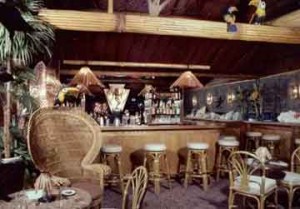
There are some great books and a few other websites that can give you an in-depth history of Tiki Culture in America. That’s not what this page is all about – I’m going to give it to you in a nutshell, so you can get the basics down before you finish your Mai Tai.
The common theory is that Tiki Bars started popping up in America after World War II, when soldiers returning from the South Pacific started spreading the word of how wonderful the beautiful tropical islands were with their hula girls and swaying palms. Well, that’s not really true; the first Tiki Bars in America, by most accounts, were started in the 1930s by a couple of guys who had spent time in the islands and thought it would be fun to theme their bars with a tropical flavor.
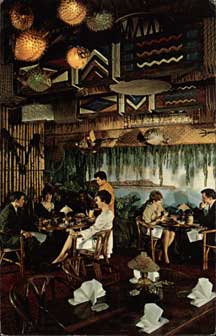
Don the Beachcomber (Donn Beach) is generally credited as the first swanky kat to open a specifically Tiki/Polynesian-themed restaurant and lounge in Hollywood, CA in 1934. About three years later Trader Vic’s (Vic Bergeron) opened in Oakland, CA with a similar theme, and Tikiness in America took off from there. Both proprietors got popular concocting strong but tasty cocktails, and soon became known for the exotic décor, laid back atmosphere and strong libations. Bamboo and wicker galore, hand-carved Tikis, palms, pretty girls in sarongs. Hawaiian music set the standard for the blossoming era.
As air travel helped bring the world closer in the ’30s and ’40s, Hawaiian and Polynesian music, food and décor became more popular in the states. WW2 brought these cultures to the forefront, and Americans – who were sick of the war – focused on the beauty of these worlds, the tropical flowers and orange sunsets, the magic, the exotic women, the cool breezes and sweet fruits.
After the war, those returning soldiers did want forget the bloodshed, but they certainly wanted to remember the good times. Tiki Bars sprang up all over the states, moving from the California coast clear over to the Atlantic. New Tiki Bar owners combined elements of Hawaii, Tahiti, the Philippines and other Pacific cultures to decorate their lounges. Bamboo, thatch and carved hardwoods became the building materials of choice. Tiki idols and masks adorned the walls and bar. Nautical props, from fishnets to lanterns made from blowfish, found their way into the design. Chinese and Japanese cuisine infiltrated the menus. Swinging Hawaiian music was combined with jazz and exotic sounds of the far east and south Pacific to create “Exotica”, the soundtrack to Tiki. Polynesian Pop was born.
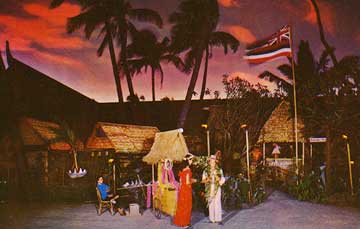
The 1950s saw an explosion in pop culture that wouldn’t be matched until the advent of the World Wide Web. Tiki bars flourished in the ’50s, giving the cocktail set a new place to mingle as well as providing a nice, close-to-home adventure for the thriving middle class. Visiting a Tiki Bar with a live Polynesian music and dance floorshow was like taking a mini vacation. Drinks were served in coconuts, hollowed pineapples, and eventually artistically created ceramic Tiki mugs. Patrons could buy souvenirs to take home, just like on vacation, and soon these souvenirs became collectibles. Those who loved the themed lounges took it upon themselves to re-create the atmosphere at home, and the home Tiki Bar was born. Although it had been hip for years with the cocktail set to have a home bar (usually anything from a hideaway bar to a corner set-up with all the frills), suddenly Tiki Bars in the home became the “in” thing. Bachelor pads were re-worked with the Tiki Theme in mind, sporting curious Moai art sculptures and black velvet paintings of Tahitian women laying naked on the beach. Swingin’ couples transformed their mid-century modern apartments to include bamboo furniture, palm plants and floral wallpaper. Basement rec-rooms across the country were turned into little Tiki islands, with fishnets hanging from the rafters and rum-stocked bamboo bars as the focal point. America loved Tiki.
Then the 1960s came along. The happy days of the ’50s began to decay under the rebellion of the hippy generation (who of course had their own ideas of ‘cool’), the problems America faced with civil rights, assassinations, corrupt government and the Vietnam war. Once again palm trees and thatch huts were shown on the 11 o’clock news as the center of war and death. Even Gilligan’s Island couldn’t distract people from the darkness. America was beginning to focus more on what was “real” and less on the fantasy, and much of the fun stuff we enjoyed in the old days were abandoned, washed away by a tide of indifference. By the 1970s, Tiki culture had been worn down to ‘kitsch’. It was no longer considered a fun, exciting escape; it was considered an old, out-dated and corny style that belonged to the old generation. Disco took over, and Tiki Bars around the country began closing their doors for good.
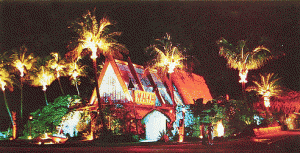
But something strange happened. Something wonderful. Tiki started popping up again in the strangest places. TV shows like “Hawaii 5-0”, “Fantasy Island” and “Magnum P.I.” brought the tropics back into our homes, in a very groovy way. A few of the old Tiki Bars continued to succeed, managing to push on in spite of the times. Places like Key West and San Francisco somehow managed to keep the culture quietly alive, adapting to new trends. The Florida Keys branched out with its own Tiki culture, breaking from tradition and incorporating vivid colors, open-air bars and Parrot Head music with Jimmy Buffet at the musical wheel. Pirate culture, which is a hairline away from Tiki Culture, gained popularity, and the two started to overlap in a wonderfully adventurous way. A couple of authentic, mid-century Tiki bars, such as the Mai Kai in Fort Lauderdale, FL managed to maintain the original, traditional Tiki Culture with Polynesian shows and exotic drinks served in original-style Tiki mugs. They pressed on, and by the early 1990s more and more Americans started opening their eyes to the wonders of Tiki. Tiki culture was rediscovered!
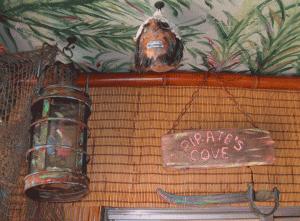
Where is Tiki?
You don’t have to live in the tropics to enjoy the Tiki life, but it helps. Having year-round warm temperatures, green grass and palm trees in your back yard is something I don’t ever want to give up. But some of the best Tiki Bars I’ve been to have been in places like Portland, Oregon – so it’s really a state of mind, more than a place. You can live in Alaska, as long as you have your bamboo and thatch setup and a good heater, you’re golden.
It was guys like me (and maybe you too) who kept the Tiki torches burning through the last few decades. My father loved the whole Tiki thing, and built me my first Tiki Hut to play in back in the ’70s, along with a Pirate Ship and a Tiki/Pirate-themed bedroom. I built my first basement Tiki Bar in in my first house in 1996. By that time, Tiki Culture was making its way back into the hearts of many Americans, not just us crazy few. Books on the allure of Tiki were published. Tropical themes became “in” again. More TV shows and movies were set in tropical settings. And the Internet helped propel the good word of the Tiki good life around the world. (That’s why you’re reading this, right? Dig it!)
Now, at the beginning of the new century, we’re realizing once again the fun of Tiki and the importance of preserving the original places, ideals and philosophies that make Tiki Culture so great. From hard-core traditionalists to new-wave Parrot heads, people all over the world are enjoying tropical drinks under indoor palm trees, swaying to music by Martin Denny and The Martini Kings. There are Tikiphiles who love and live everything Tiki, and everyday people who think it’s just kinda kool to have a Tiki mask hanging in their bedroom and bamboo furniture on the lanai.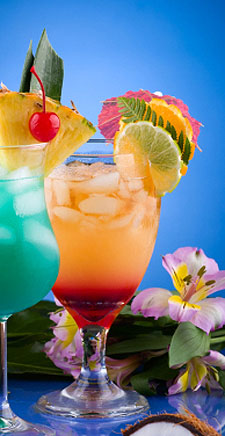
Where do I fit in? Well, I never considered myself to fit into anything, really. Personally, I’m my own kind of kat who digs a lot of different things, most of them being cars, clothes, music and booze from the 1930s through the 1960s. Tiki Culture is a big part of the big picture for me. I live in south Florida and my home is decorated in a combination of Island, Tiki, mid-century modern and antique sprinkled with new technology and conveniences. And I can pull it off, because it’s all about me and my tastes (and my wife’s too!). Some people prefer to stick to one era and are true to it, and that is very kool. Others are all about original Tiki, basically Poly pop of the 1950s, and won’t stray from it. That is kool too because they are the kids who keep the traditional stuff going and that is very important. And many are all about back-yard Tiki, having a luau party with the fun, colorful decorations you can pick up cheap at the party store, lighting the Tiki torches and barbecuing sweet and sour chicken kabobs while the kids do the limbo.
To me, it’s all fantastic. Tiki culture is all about living the good life, having fun, and enjoying the tropical splendor it offers. So sit back in your bamboo chair, sip your Piña Colada with the little paper umbrella, and dig in to the fun of living Tiki!
– Tiki Chris Pinto, for Tiki Lounge Talk
Wait, there’s more! Here’s a fun little thing…What is NOT Tiki…
• Carribbean, South American, Mexican or African cultures. Although elements of these cultures make their way into the Tiki lifestyle occasionally, they are their own cultures and don’t really represent Tiki.
• Anything with folk music. Oof. If there’s a guy with a guitar singing Simon and Garfunkel tunes, no matter what the joint has hanging on the walls, it ain’t a Tiki Bar.
• Art Deco, palm tree & pastel decor, i.e. Miami Modern. Just because there are palm trees doesn’t make it Tiki. That’s a whole other thing. A very kool thing, but a whole other thing.
• Chinese or other oriental decor, although Tiki borrows from those styles (especially for the food!). Chinese and Japanese elements worked into the overall Tiki theme is good.
• Friday night Beef & Beer at the American Legion Hall (unless they decorate it with Tiki stuff, of course).
• Sears.
• “Idaho. I have never heard of a Tiki Bar in Idaho. If anyone knows of one, please send info right away.” Well guess what? I was just told about a Tiki Bar in Idaho! And that is amazing, and fantastic. The more Tiki bars, the better!
• People who wear Hawaiian shirts with shorts, black socks and sandals. No.
• Martini bars, even of they have a neon palm tree in the window.
• And for Tiki purists, anything made of cheap plastic and bought at the local party store, neon-colored Tiki stuff, smiling Tikis, and misuse of Tiki gods (like Ku holding up a cheese platter) are unacceptable.
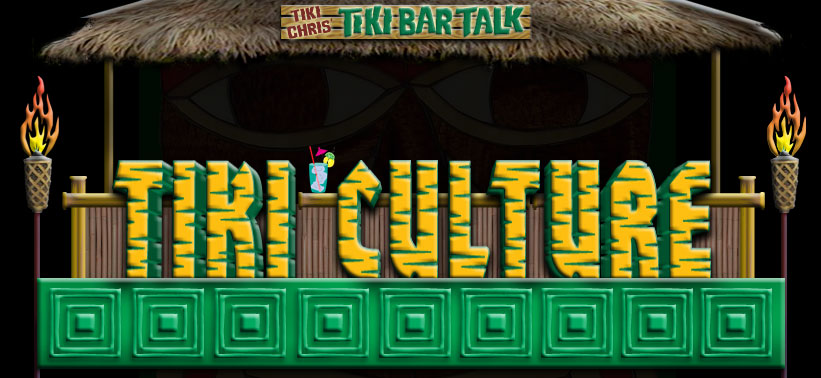
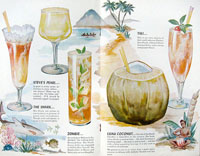
tjokpgf